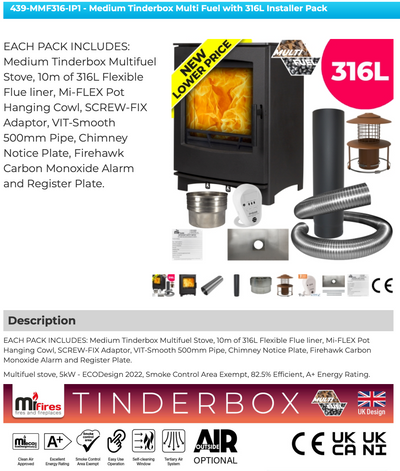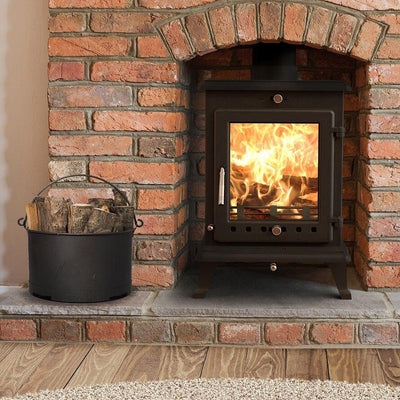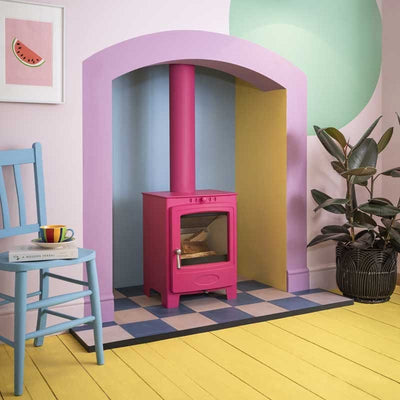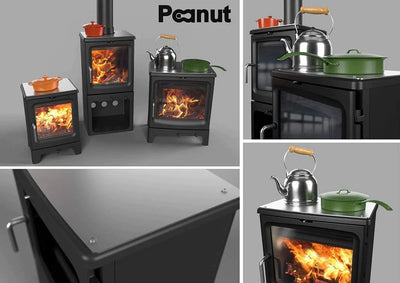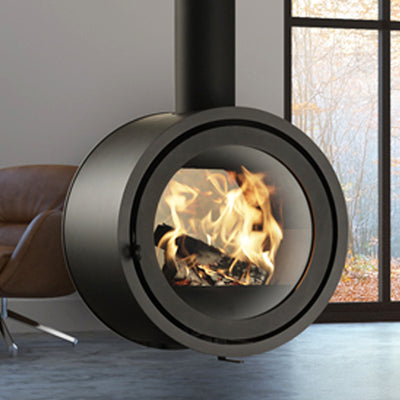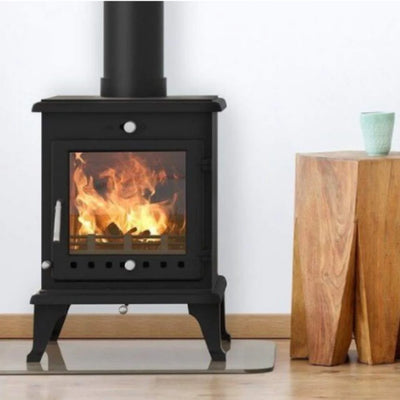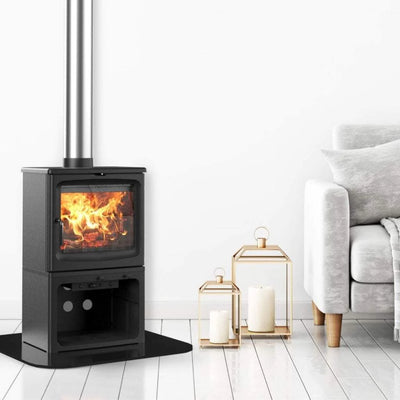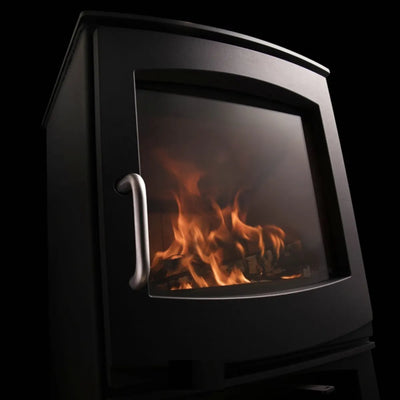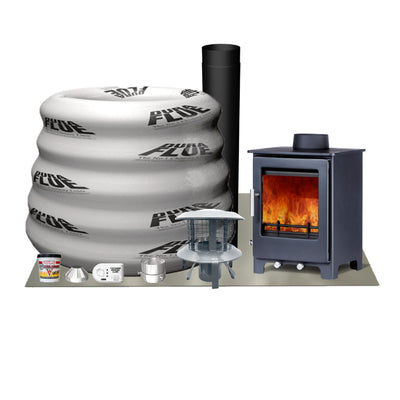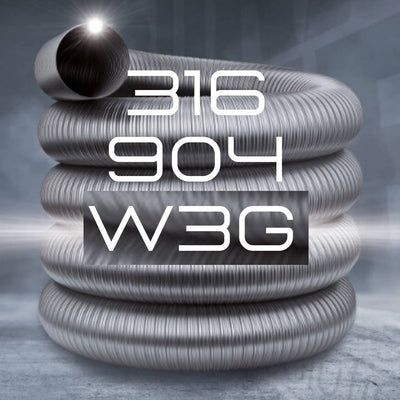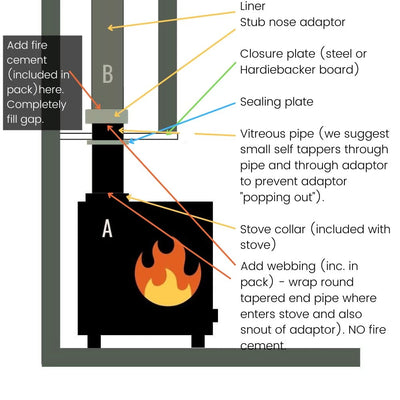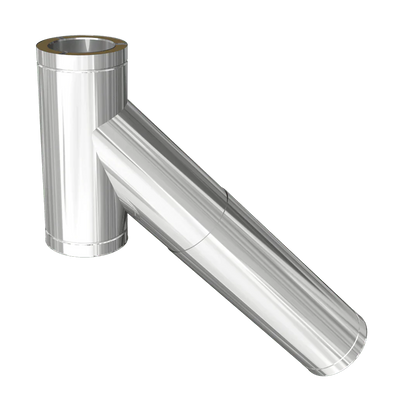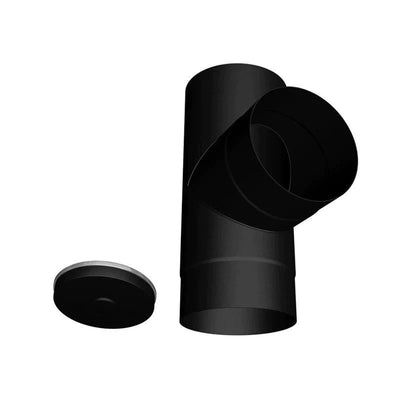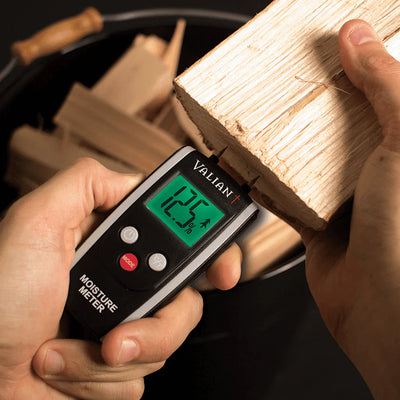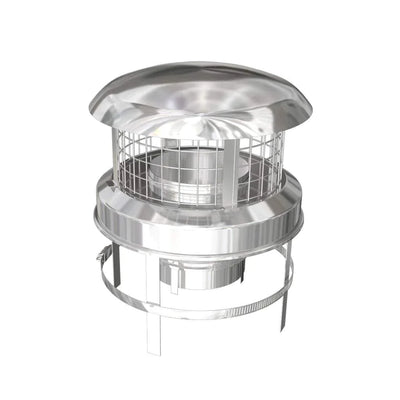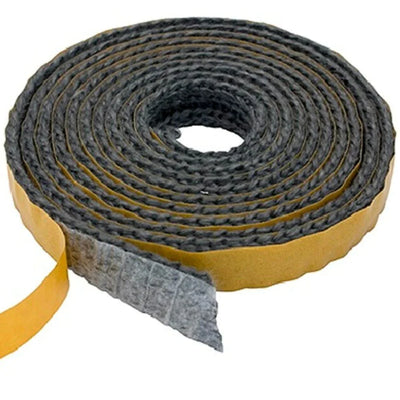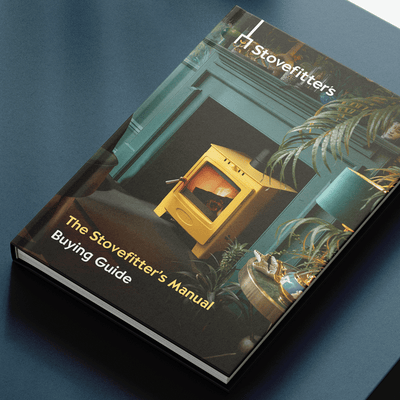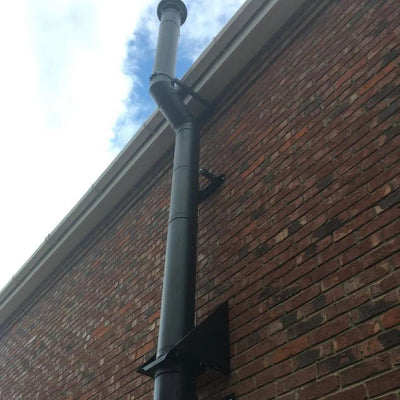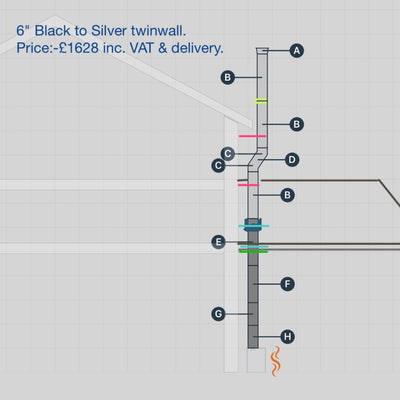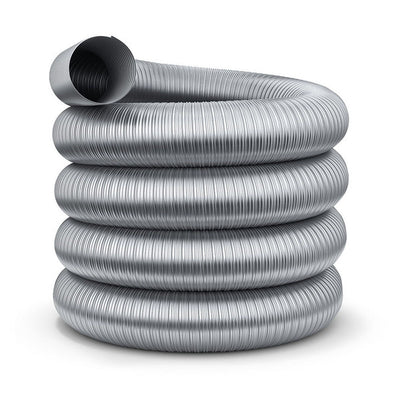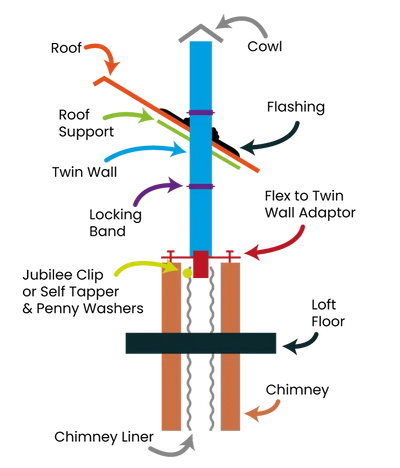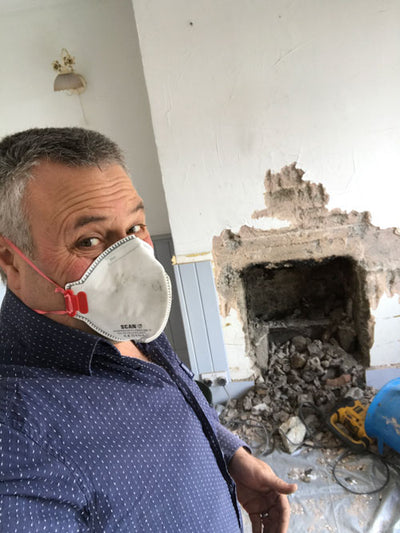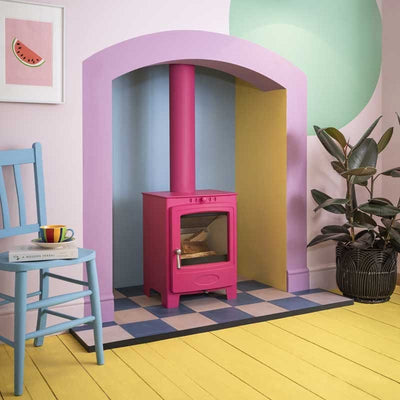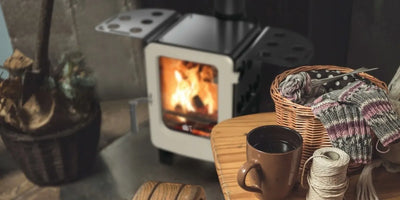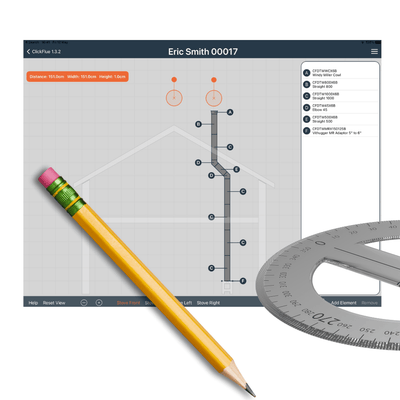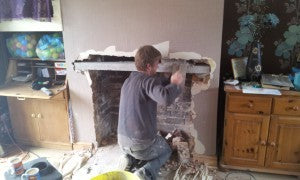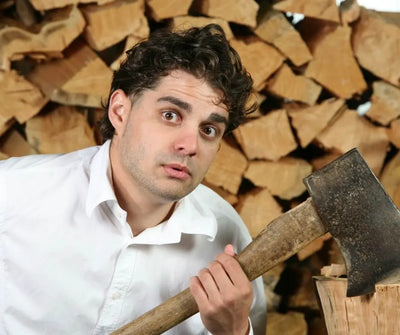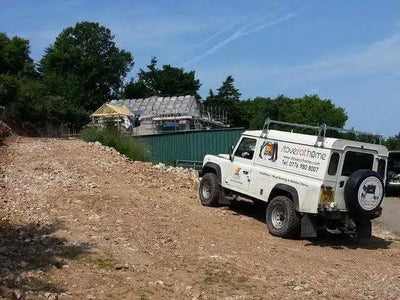Wood burning boiler stoves, hot water and radiators
5 mins
Wood burning boiler stoves, hot water and radiators: an introduction
WE NO LONGER GIVE ADVICE ON BOILER STOVES ASIDE FROM THE ARTICLES ON THIS SITE.
NOTE THAT I ALWAYS INCLUDE A VENT ON MY STOVE CIRCUIT DIAGRAMS EVEN IF IT ADDS DETAIL NOT REQUIRED FOR THE POINT I AM TRYING TO MAKE. THIS IS A CRITICAL SAFETY FEATURE AND ALLOWS THE SYSTEM TO LOSE STEAM (PRESSURE) SHOULD IT BOIL. ON ANY SOLID FUEL CIRCUIT THERE SHOULD BE A ROUTE TO VENT THAT HAS NO RESTRICTIONS OR POSSIBLE RESTRICTIONS (NO PUMPS/TAPS/VALVES NO ANYTHING). JUST PIPE (MIMIMUM 22MM DIAMETER FOR VENTING PURPOSES). NO FUNCTIONING VENT MEANS YOUR STOVE WILL EXPLODE LIKE A BOMB.
There are a few stoves that can be fitted to unvented circuits. This is a very specialised area and outside the scope of this website.

Where should I start? Well I am going to go right back to basics for solid fuel and wood burning stoves and keep things simple. Forgive me if you are ahead if the curve on this. Time for some scribbles:
It is important to realise that all of the pipes are full of cold water almost to the top of the vent pipe (circuits fill from loft header tanks and will circuits will fill to same level as header tank).
All solid fuel stove circuits centre around one basic principle: hot water rises through cold water (hence why when you swim in the Med the water gets colder if you dive down a few metres). In the scribble above the stove has been lit and the water within the stove (in a metal box within the stove or in the jacket of the stove) heats up. The heated water rises to the top of the stove and starts to rise up the pipe that is connected to the top of the stove (the red pipe in our scribble). Because warm water is leaving the stove, cooler water from the orange pipe flows into the stove to replace what has left. As things heat up so the speed of this process increases and we end up with a circuit of fast flowing water: up the red copper pipe, through the copper coil and down the orange copper pipe. This is what is often called “gravity circulation”. Note that no pump is required! The benefit of course is that the water in the cylinder itself is gradually heated by the hot coil (the cylinder is known as an “indirect cylinder”). Note that the water in our primary circuit never mixes with the main mass of water in the cylinder (primary circuit water has a chemical known as “inhibitor” added to it to prevent rust).
It should now be obvious that the diameter of the pipe for the gravity circuit is important. If the water rising up the red pipe cannot get away from the stove fast enough then it will stay in the stove longer and might boil (not good). Hence the primary circuit pipework will increase in diameter as the stove power increases. For stoves under 35kw 28mm diameter is recommended.
Note that the cylinder in the above picture can be replaced by a radiator should domestic hot water not be required (this detailed further down).
The stove does not boil because the hot water rises up the red pipe and is cooled whilst it travels DOWN through the coil (because the water in the cylinder itself is cold and therefore cools the coil). Hence the red pipe (we call this the FLOW) is hotter than the orange pipe (we call this the RETURN). Note that the flow pipe is always connected to the top of the cylinder coil (from the top of the stove).
The cylinder is acting as a HEAT SINK (a term we will come across again), in other words it is stealing heat from the primary circuit. This means that the red pipe (FLOW) is hotter than the orange pipe (RETURN) and as long as this continues the circuit will flow. Of course the cylinder water will gradually increase in temperature and will, at some stage, not cool the coil – then then gravity circuit will slow and will eventually stop (leading eventually to everything boiling). We will come back to this scenario.
If a boiler stove has two pipes then the primary circuit attaches to those two pipes (flow to higher pipe). If a boiler stove has four pipes then the primary circuit will attach to two of the four, corner to corner. Imagine the four dots on dice: the flow attaches to either of the top two pipes whilst the return attaches to the opposite corner on the bottom of the stove (in this case the other two are for the radiator circuit or can be capped).
Let’s look at a system design that will not work:

You should have at least two metres of height between the centre of your boiler and the centre of your coil (some people suggest one metre is sufficient) for the gravity flow to take place effectively. Gravity flow is assisted by vertical separation between heat source (stove) and a heat sink (in this case the cylinder). This is why cylinders and airing cupboards are upstairs, often directly above fireplaces. Gravity flow is also assisted by fat pipes (check with stove manufacturer but 28mm diameter is the norm) and shallow bends (e.g. a bend created with a pipe bender is better than a 90 degree elbow and two 45 degree fittings next to each other are better than one 90 degree fitting so if no bender available do what I do and make all your corners from two 45’s!). You might think “well I’ll just pump it”. This is not acceptable. If you have a power cut or the pump fails then the water will boil. If your cylinder is on the same floor as your stove there are other circuit designs that will work (we will come back to this).
Everything I have described so far is what is called THE PRIMARY CIRCUIT. The primary circuit operates without a pump and has a heat sink at the top of its circuit. The primary circuit is at the centre of any solid fuel stove circuit. In any power cut or equipment failure this circuit is always in place and will always prevent the circuit boiling (unless you really rev up the stove to overpower the heat sink).
Our aim is to create a system that will not boil – even in a power cut. If all else fails and it does boil – it will be safe.

Obviously it is not always possible to go vertical without having some horizontal*. But how far horizontally can you go? And how long can your pipes be? To be honest I have never quite discovered the limits (maybe I am rather conservative). I have seen many systems work that I would have expected not to work. As a rough guide I would travel at forty five degrees rather than horizontally if at all possible (often not possible of course because of aesthetics but remember you can always box pipes or add a thin false wall). Distance of pipework (length of pipework)? If the stove is within 10m of the heat sink then don’t worry about it. I am not sure how far one can push this. I have though seen a working system with the heat sink at least 20m away (10m of gradual horizontal rise combined with 10m vertical).
Good practice: If you have to go horizontally make sure you go vertically first, as close to the stove as possible, to get the circuit going (a common scenario is to leave the stove on a slight rise, travelling through the sides of the chimney breast before following the breast vertically upstairs to a heat sink). Between stove and heat sink do not travel horizontally more than half what you travel vertically (I believe that you can quite happily push this to 50:50 but have not experimented enough to recommend this… maybe somebody out there has a formula?)
*Note: Horizontal should never actually be horizontal. All pipework between stove and heat sink on both flow and return should have a slight rise (the more the better but any rise is acceptable). This is to allow any trapped air to rise up to the vent and escape. Even off the back of the stove pipework should have a slight rise.
GOLDEN RULE: NEVER HAVE A DIP IN PIPEWORK – no section of pipe should be horizontal or point downhill as air will trap here.
Have as few bends as possible. If possible use a bender. If not use two 45’s rather than one 90.
We choose our stove brands carefully and work with: DG, Saltfire, Hobbit, Hamlet, Ekol, Arada, Flavel, Heta and more.
We test stoves, one stove a month and disregard any models found wanting.
The top sellers that are not boiler stoves are: DG Ivar 5, Hobbit, Saltfire Peanut Bignut, Saltfire Peanut 5, Firewire, Flavel Arundel, Hamlet Solution 5 Widescreen, DG Ivar 8, Saltfire Scout, Woodford Lowry, Saltfire Peanut 3, Heta Inspire 45 and Ekol Applepie.
We recommend a good quality 904 316 chimney liner for use with a boiler stove as boiler stoves can be pretty hard on liners (go for the 904). A similar situation with twin wall flue, stove pipe and any flue system - buy good stuff.
Via our Stovefitter's Manual we have DIY advice on hearth sizes and rules, chimney lining, register plates, heat shields, fireplace breakouts, conservatory installs, shed installs, garage installs and more.
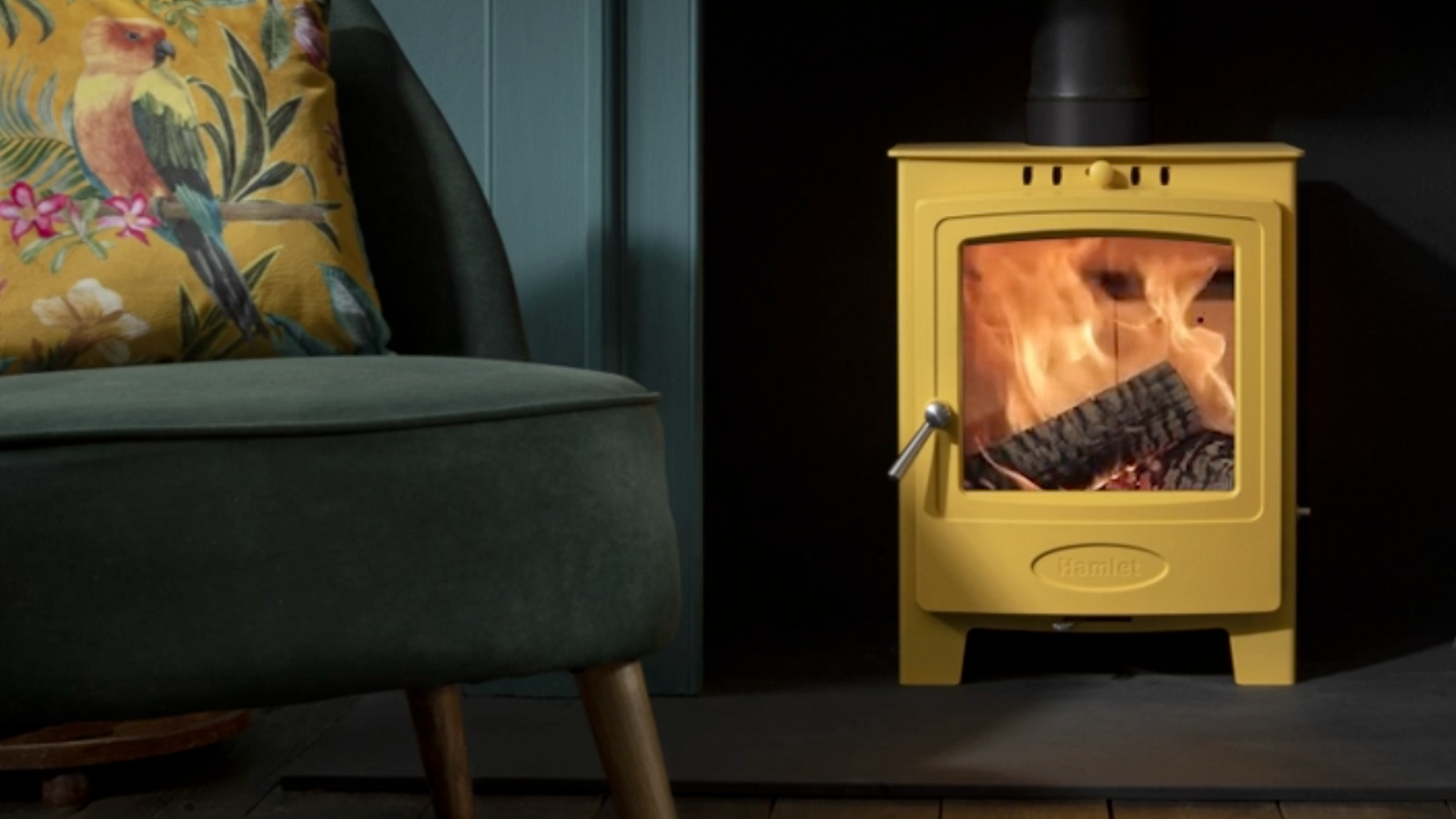
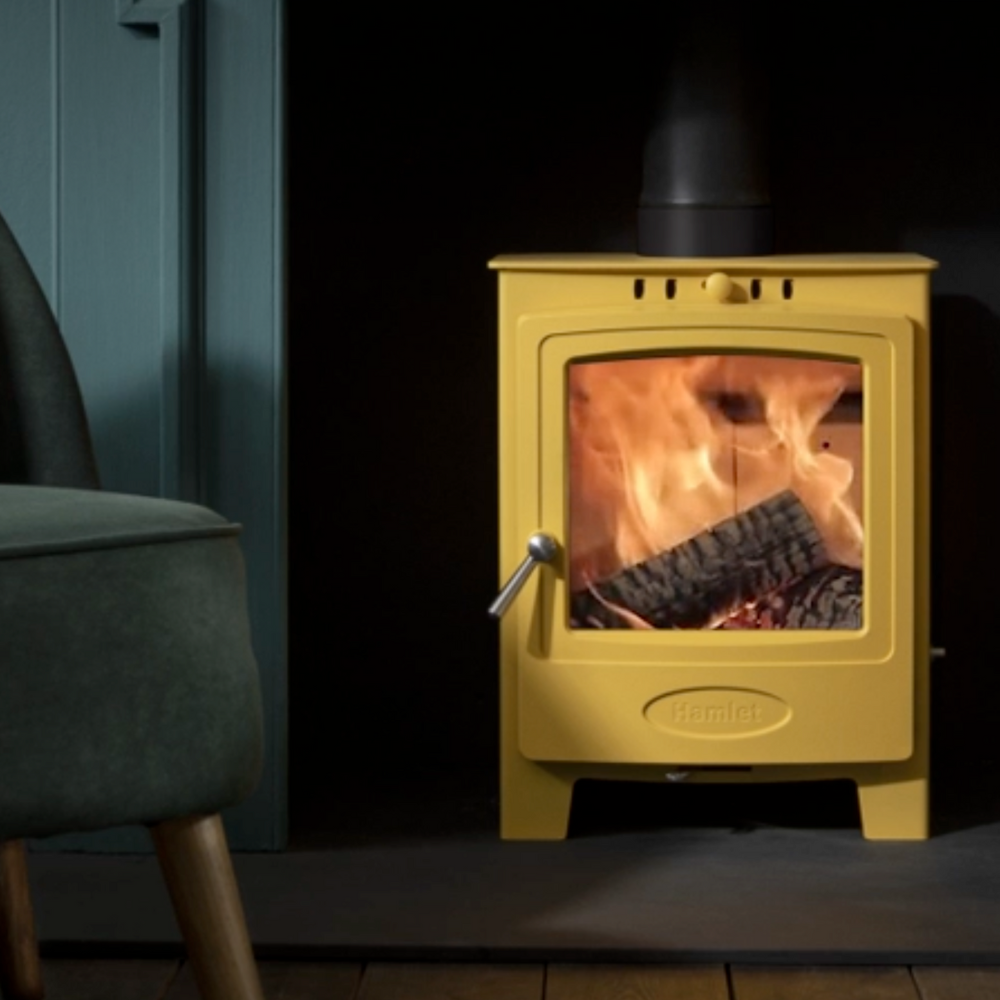
How to choose chimney liner & how much to buy


Installing a stove in a fireplace - what do I need?
FAQs
See all FAQsCosts correct as of April 2023:
Approx. costs if you have a chimney and fireplace ready to use: £750-£1,000 (save £500 by self-installing).
Approx. costs if you have a chimney but need the fireplace "opening up": £1,600-£2,200 (save £1200 by self-installing).
Approx. costs if you do not have a chimney and need a clip-together flue: Shed £475-£700. Bungalow £1500. 2-storey house £2500. Save £1,000-£1400 by self-installing.
Above figures include labour and materials but no appliance.
We, of course, advise you to purchase your stove and materials from Stovefitter's to ensure quality goods are installed (some installers use budget materials to increase margin). If you buy your stove from us (rather than your local small shop or installer) we have a lot more power when approaching manufacturer's with a warranty issue. Why is that? Because we buy many hundreds of stoves a year from these brands.
We do not fit stoves.
But we know a few who do!
Google: Hetas installers
Hetas are the trade body of registered UK installers.
Most installations will require that you slide a chimney liner down your chimney (flexible metal tube 5" or 6" in diameter). Do you have a narrow chimney and want to lessen the risk that a liner might not go down your chimney? Then make sure your chosen stove can use a 5" liner.
Must I line my chimney? Best read this article but most likely the answer is yes. Do I have to fit a chimney liner?
DEFRA-Exempt wood burning stoves with a 5″ collar can usually be fitted to a five inch liner rather than the usual 6″ minimum, making the installer's job much less stressful.
ALL OF THE 5KW STOVES WE SELL CAN BE FITTED TO A 5" CHIMNEY LINER.
I seriously suggest any self installer fits a 5" liner unless they know their chimney is large enough for a 6"!
What is the best chimney liner? Silvacore 904 (we sell it so of course we will say that ;-). What is the best chimney liner?
Useful links
Will your stove require an air vent within the room (some stone walls are very difficult to drill)?
5kW or under and wood burning stoves often do not require an air vent (new builds always require an air vent).
Useful links
What is the maximum output in kW of your "5kW" wood burning stove? The majority of manufacturers just specify the “nominal output” and this figure means very little in real life. The nominal is a figure the manufacturer chooses to sell the stove at - the stove is capable of reaching at least this output with one fuel load. Nominal means "capable of". But it is not the maximum.
Check out the size of the area where the logs will go (firebox size) as this varies enormously. The kW output is completely dependant on the amount of logs burning at any one time - more logs burning equals more heat. If you can fit three logs in stove A and just two logs in stove B then stove A will be capable of throwing out 33% more heat.
DO NOT TRUST MANUFACTURERS’ kW RATINGS as manufacturers specify what output they desire to sell the stove at and testing allows for much “playing with the figures”. This is why you can get very small 5kW stoves (e.g. Aga Little Wenlock) and very large 5kW stoves (e.g. DG Ivar 5 by Dik Geurts which is actually rated 5kW but has a MUCH larger firebox than the Ekol Crystal 5 by Ekol Stoves). A Crystal 5k might get to 5kW and not be capable of any higher whilst a DG Ivar, despite being rated at 5kW, can get to 8kW with a full fuel load.
Note that, over time, one might damage the internal firebricks of a stove by running at a higher load than the manufacturer's suggest. Firebricks are easily replaceable.
Useful links
Will your wood burning stove fit in your recess WITH the required air gaps around it? This is obviously not an issue if your stove will be freestanding.
Air gaps to non-combustible materials (brick, stone etc.) are usually "as close as you like" legally but manufacturers will sometimes specify a recommendation. This recommendation is there to allow heat to escape from the recess into the room - so you get the heat benefit rather than the heat soaking into the building structure and being lost. If no gap to non-combustibles recommended then we suggest 50-100mm air gap left and right of stove, 50mm behind and 100mm above.
Are you in a Smoke Control Area (usually built up areas)?
Choose your stove accordingly.
A stove must be DEFRA-Approved if you wish to burn wood in a smoke control area.
ALL OF THE STOVES WE SELL ARE DEFRA APPROVED FOR SMOKE CONTROL AREAS.
In simple terms if a stove has an efficiency rating of 70% then 30% of the heat from your logs goes up the chimney.
If a stove has an efficiency rating of 90% then only 10% goes up the chimney.
So think of this in terms of how many logs you have to chop/buy.
Example: A Saltfire Peanut 5 by Saltfire Stoves in Dorset has an efficiciency of 80%.
A tall chimney (6m or more) that is lined will be happy with an efficient stove.
Efficiency importance can be said to be overrated and anything between 75% and 85% is fine. Go much higher and performance can actually suffer (smoke in room when opening door to reload, blackening of glass).
Many modern stoves can go on 12mm thick hearths. Others require full, 5″ thick constructional hearths. All of the stoves we sell state whether or not a 12mm hearth is suitable.More about hearths for wood stoves here.
Helpful links
Can you can talk to somebody on the phone should you need to after the wood burning stove has been delivered, especially if you are self installing? Will the staff at “wesellzillionsofstoves.com” be able to assist with any installation issues? What if there are any problems after install?
Do yourself a favour before ordering stoves or materials on the Internet: Go to Trustpilot and type in the company name before you buy. Some companies advertising at the top of search engines are not good news - check for yourself.
When striving to find thebest 5kW wood burning stovesyou will likely be bewildered by the choice. There are many to choose from. The question I get asked most in our shop is “why should I pay <£1,000> for this one when this other one is just <£500>?”. Here is the very simple answer:the cheaper wood stoves are made in Chinaor Eastern Europe whilst the more expensive are made in Western Europe (or sometimes the USA). Here are a few examples where a more expensive stove might excel over a cheaper stove:
- Aesthetics (more time spent on design)
- Hinges (sometimes hidden on more expensive stoves)
- Better quality glass
- Thicker steel (longer life)
- Improved door locking mechanisms
- Longer warranty
- Improved controllabilty of flame due to more resource invested on design of air flow within stove
- Brushed steel fittings instead of cheapy chrome look
Open and close the door on a cheap Chinese stove. Then open and close the door on a DG stove, Arada stoves, Woodford stoves, Hamlet stoves or Saltfire stoves. You’ll understand the difference.
Stove pricing reminds me of wine pricing. A £20 bottle of wine is not double the quality of a £10 bottle of wine (the drinking experience might be improved by 20% as an example). We are talking “the law of diminishing returns here. They are all “fire in a metal box” at the end of the day.
Yes. However, there are specific regulations and restrictions in place to address air pollution concerns, particularly in areas designated as Smoke Control Areas. In these areas, only approved "smokeless" fuels or exempt appliances, such as Defra-approved wood-burning stoves, can be used. These stoves are designed to burn wood more efficiently and produce fewer emissions.
All the stoves we sell are DEFRA approved and Eco-design approved and suitable for all areas of the UK.
Terminology
View all TerminologyA stainless steel tube, slides down a brick/stone chimney to provide a smooth and safe route for smoke.
All of our stoves are approved by DEFRA to burn wood in all UK locations including Smoke Control Areas (towns and cities). Not all stoves are, so be careful if buying elsewhere.
All of our stoves are ECODESIGN approved to be sold in the UK. Not all stoves are, so be careful if buying elsewhere. ECODESIGN is mandatory by law since January 2022.
The base your stove sits on.
If the chimney is the polo mint then the flue is the hole.
Buying guides
The Stovefitter's Manual

How to choose a wood burning stove for your property (includes infographic)
Infographics

What size wood stove do I need? Don't let manufacturers fool you!
Buying Guides
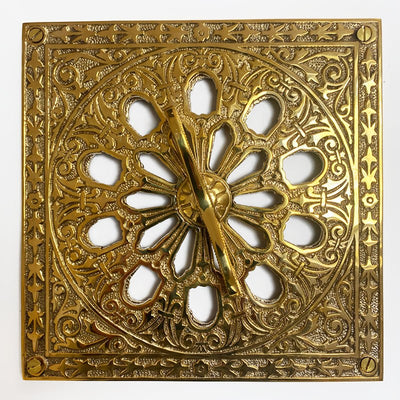
Do I need an air vent for a wood burning stove? If I do not bother?
Buying & DIY

Knowledge Tree: Process of buying and installing a wood burning stove
Buying & DIY
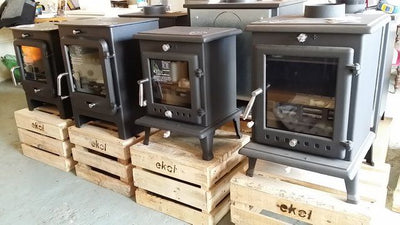
Chinese wood burners – should I buy one or are they all crap?
Buying Guides

What else do I need to buy to install a wood burning stove?
DIY Guides

Infographics for wood burning stove purchase and install
Infographics
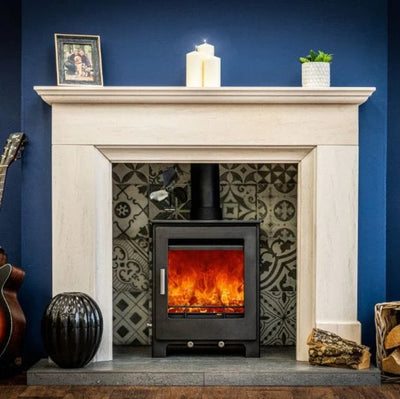
Wood burning or multifuel stove? A stove fitter decides.
Buying Guides
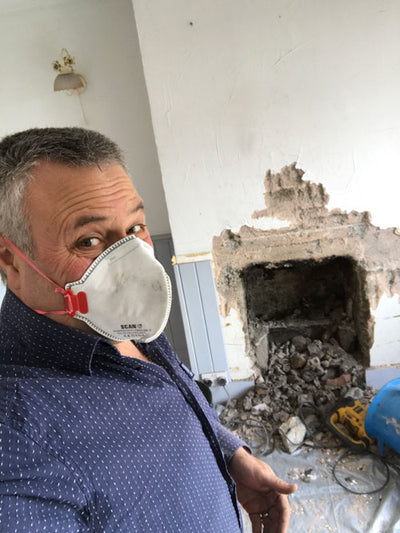
A few words from Julian
Buying & DIY
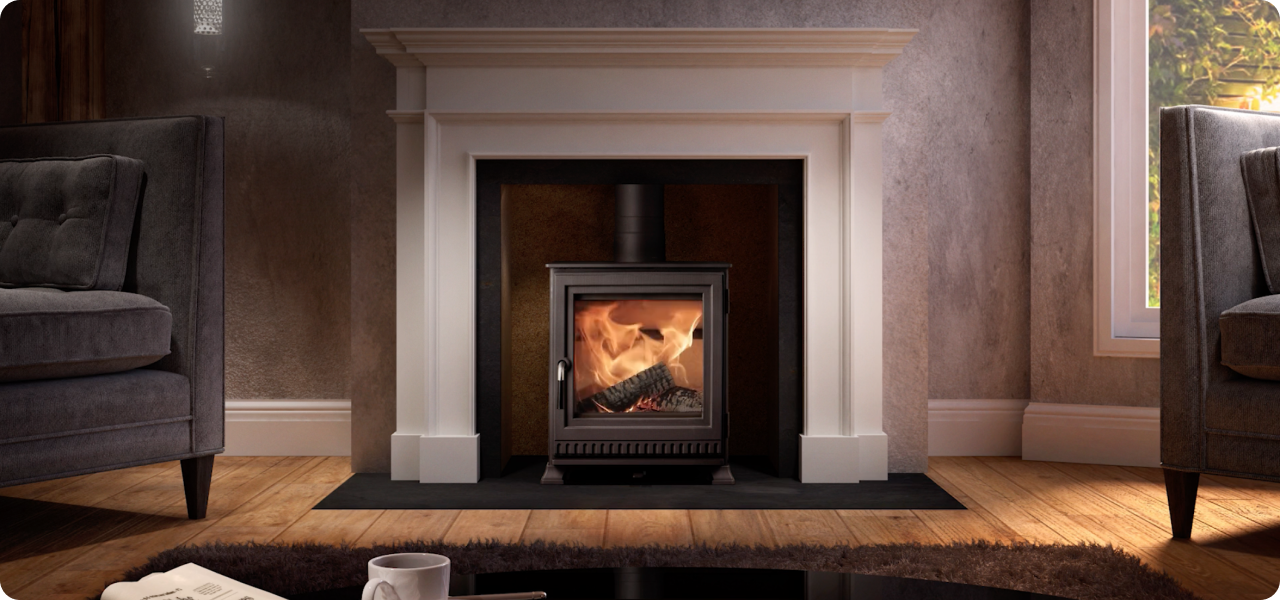
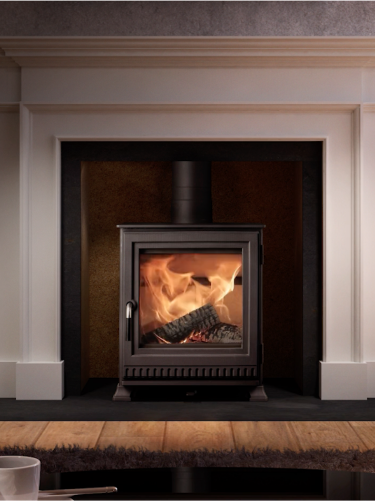
Find my perfect stove
Answer 3 simple questions and we will show you the best Stoves for your space.


